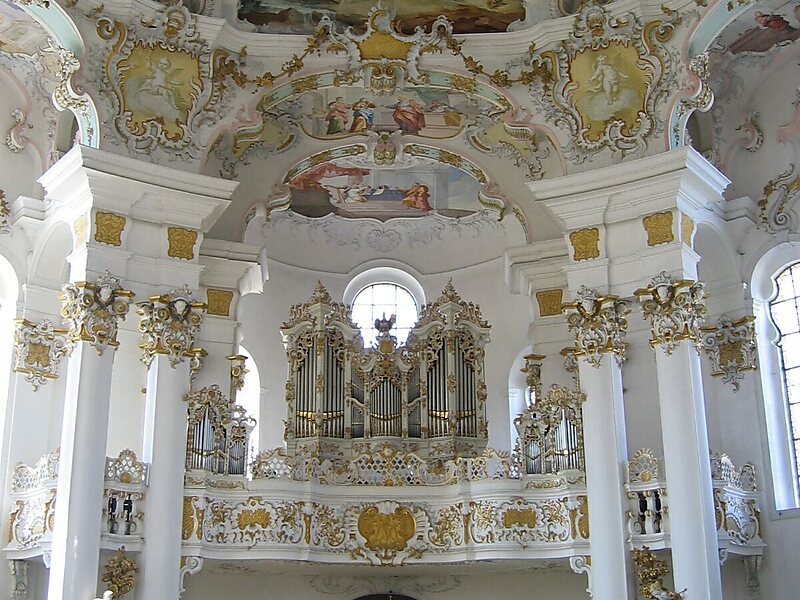Germany – Bavaria (Munich, Nuremberg, Würzberg) September 9-10, 21, 2019
Miltenberg. A NM “small town”,
WÜRZGURG
Marienberg Fortress
Alte Mainbrücke (Old Main Bridge).
Würzburg Residence with the Court Gardens and Residence Square
Kulturspeicher
BAMBERG
Barely touched in WW II (only 4.6% destroyed), its medieval old town is another WHS. Built on seven hills, it is full of very narrow, twisting medieval lanes, and rivers. It is best walked as it can be a driving nightmare. The Town of Bamberg is a World Heritage Site.
Old Town Hall. The highlight of Bamberg, it spans the Regnitz River on an island accessible by bridge form both sides. One side has a baroque fresco and the other side is half-timbered.
Bamberg Cathedral. Founded by Heinrich II and consecrated in 1021, it burned to the ground 69 years later and rebuilt in 1102-39, burned again in 1183 and rebuilt, consecrated in 1237, and is still standing today. The Prince’s Portal has a scene from the Last Judgement with the blessed smiling and damned having distorted faces as they are led off by the Devil to hell. The 17th century Baroque interior was restored to Neo-Romanesque in the 1800s. The Bamburg Horseman painting portrays an unknown rider (many theories). The tomb of Heinrich II and his consort Cunigunde has the royal couple on a slab on top with scenes on the sides of their lives. The 1380 choir stalls have carved prophets, apostles and saints. Open 9:30-5.
Old Court (Alte Hofhaltung). Initially a fort, it became the palace of the bishops in the 16th – 17th centuries. It is now the City Musuem.
Schlenkeria. One of Bamberg’s famous breweries and tavern, it is famous for its smoked beer tapped from wooden barrels.
Klein Venedig (Little Venice). One side of the river is lined with colourful 19th century fishermen’s houses from the
St Stephen’s Church. High on a hill.
Etlangen. (pop 114,000)
Together with Nuremberg, Fürth and Schwabach, Erlangen forms one of the three metropolises in Bavaria. With the surrounding area, these cities form the European Metropolitan Region of Nuremberg. The cities of Nuremberg, Fürth and Erlangen also form a triangle on a map, which represents the heartland of the Nuremberg conurbation.
An element of the city that goes back a long way in history, but is still noticeable, is the settlement of Huguenots after the withdrawal of the Edict of Nantes in 1685. Today, many aspects of daily life in the city are dominated by the Friedrich Alexander University Erlangen-Nuremberg and the Siemens technology group.
It is a NM “European City”.
NUREMBERG/FÜRTH World Cities and Popular Towns
Nuremberg Hbf,
NUREMBERG CASTLE
A Salian royal castle stood here on the rock in the 11th century. In the 12th and 13th centuries, Emperor Frederich I Barbarossa (1123-90) and his successors built the largest and most magnificent castle complex in Germany. Between 1050-1591, it hosted the imperial court, diets and judicial sessions of all German emperors and kings of the Holy Roman Empire. After 1356, the kings held their first general assembly here. Enter the impressive long Vestner Gate.
The 13th century Sinwell Tower is round and the most obvious landmark in the castle. The deep well is 50m deep.
Imperial Castle. Only inhabited on royal visits, many parts can be visited. The Imperial Hall was used as a dining hall, was rebuilt after WW II and has exhibits on the Holy Roman Empire. The Emperor’s Living Room has an impressive ceiling with the double eagle of the Holy Roman Empire and coats of arms of other countries. The corner chamber has Nuremberg artists, gifts to the Emperor and the Imperial crown. The museum has a lot of weapons.
Double Chapel. This Romanesque chapel was built in 1200 with two floors, one above the other.
There are great views down to the walled medieval town from the bastions. €7 combined ticket for the Imperial Castle, museum, deep well and Sinwell Tower
Documentation Center Nazi Party Rallying Grounds. In the NM “The Dark Side” series, the National Socialist Party held its first party rallies in Nuremberg in 1927 and 1929, From 1933, they systemically extended the grounds around Dutzendteich Lake for their annual party rallies. It became the location of the cult, a demonstration of the power of the party. In 1934, Albert Spier planned the 11km2 area and built the Luitpold Arena, the Zeppelin Field, the March Field and the Congress Hall (Reichsparteitagsgelände, a grand grey stone building where the museum is). Nowhere else in Germany is the remains of Nazi architecture present today. €7
BAYREUTH
Margravial Opera House. Built between 1745-50 by the Hohenzollern margrave Frederick of Brandenburg-Beyreuth and his wife Princess Wilelmine of Prussia, it is one of the few surviving theatres of the period and has been extensively restored. The wooden interior was designed by Giuseppe Galli Bibiena from Bologna in an Italian Late Baroque style. The box theatre is completely preserved in its original condition except for the curtain taken by Napoleon on their march to the 1812 Russian campaign. The princess established the margravial theatre company in 1737 and was a composer of opera works, an actor and director. After her death in 1758, performances ceased and the building went into disuse, one of the reasons fro its good conservation.
Over 100 years later, the stage’s great depth of 27m attracted Richard Wagner who chose it as his festival center. The theatre was the sight of the annual Bayreuther Osterfestival form 2000-09, closed in 2012 for renovation and reopened in 2018. It is a World Heritage Sites (2012).
REGENSBURG
OLD TOWN OF REGENSBURG with STADTAMHOF. A World Heritage Sites
this is often referred to as Germany’s best-preserved medieval town. Transport yourself back through time on a walking tour through the narrow lanes, remnants of Roman beginnings, beautiful clocks, murals, doors and wrought iron signs.
Goliath House. Painting of David and Goliath dating to 1573.
St Peter’s Cathedral. Its twin spires are a landmark wherever you go in the Old Town. Built and added to from 1260-1520 replacing earlier churches that had occupied the site, it is considered the best example of Gothic architecture in Bavaria. Many statues decorate the exterior. The West Portal has elegant arches and canopies covered in small statues of kings, saints and biblical scenes. The interior is a little underwhelming and very dark. The highlight is the stained glass windows, some from 1220-30, most donated from 1320-70 and having survived the Middle Ages and WW II mostly intact. Open at 06:30-5pm.
Porta Praetoria. The ancient arched stone gate is from Roman times as part of the German Limes. It was built by Emperor Marcus Aurelius in 179 AD serving as the northern entrance to the Castra Regina Fortress and legionary camp. It faced the enemy territory of Germania and was known as the “water gate” as late as the 932. The parts visible today are 4 elements integrated into the northern façade of the bishop residence: the eastern tower (ground floor and 5 arched windows), the western archway, the eastern archway walled up with large, reused blocks and the rest of the ashlar masonry immediately next t the former western tower . It was originally 5 m high
Stone Bridge (Steinerne Brücke). Built between 1135-46, it is Germany’s oldest vaulted stone bridge and has many sections in their original state. It is 310m long, 7m wide making it the largest of its kind in the world. It was the only stone bridge crossing the Danube between Ulm and Vienna for 800 years. The best views of the bridge and Old Town are from across the river, opposite the lookout tower with great reflections in the river. It is a monster with 12 piers spanning at least 2 branches of the Danube and one island.
Old Town Hall. Dating to the 13th century, it was the fixed venue for the Imperial Diet of the Holy Roman Empire from 1663-1806. A tour is necessary to see the inside and find out the history and see the architectural details – the main halls remain medieval in appearance with marvellous wood ceilings. The Torture Chamber is a must see. If there were no witnesses to the crime, the judge required a confession from the accused, often obtained using all the torture devices whether they were guilty or not. English tours at 3pm.
Stadtamhof. Across the bridge from the Old Town, it was not incorporated into Regensburg until 1924. It is included in the WHS listing. Walk along the river and the main avenue with colourful buildings and clock towers.
MUNICH
Allianz Arena. In the NM “Modern Architecture Buildings” series, it is home to the football club FC Bayern Munich. Seating 75,000 and the second largest in Germany and opened in 2005, it is widely known for its exterior of inflated ETFE white plastic panels kept inflated with dry air to a pressure of 3.5 Pa. Up close you can see through the .2mm thick foil. It was the first stadium in the world with a full colour changing exterior- red, blue or white. It can be seen at night from the Austrian mountain tops, a distance of 80kms. With financing, it cost €360 million.
It is totally owned by the football club. Allianz purchased naming rights for 30 years but the name cannot be used for FIFA and UEFA events that prohibit corporate sponsorship from companies not official tournament partners. It contains the museum of Bayern Munich. The roof’s sunshade blinds can be rolled open and still cover all seats. It has 2000 business seats, 400 press seats and luxury boxes with seating for 164. There is a megastore for team merchandise. It has 550 toilets and 190 monitors. The parking is Europe’s largest underground car park with 4 levels and 9.800 spots.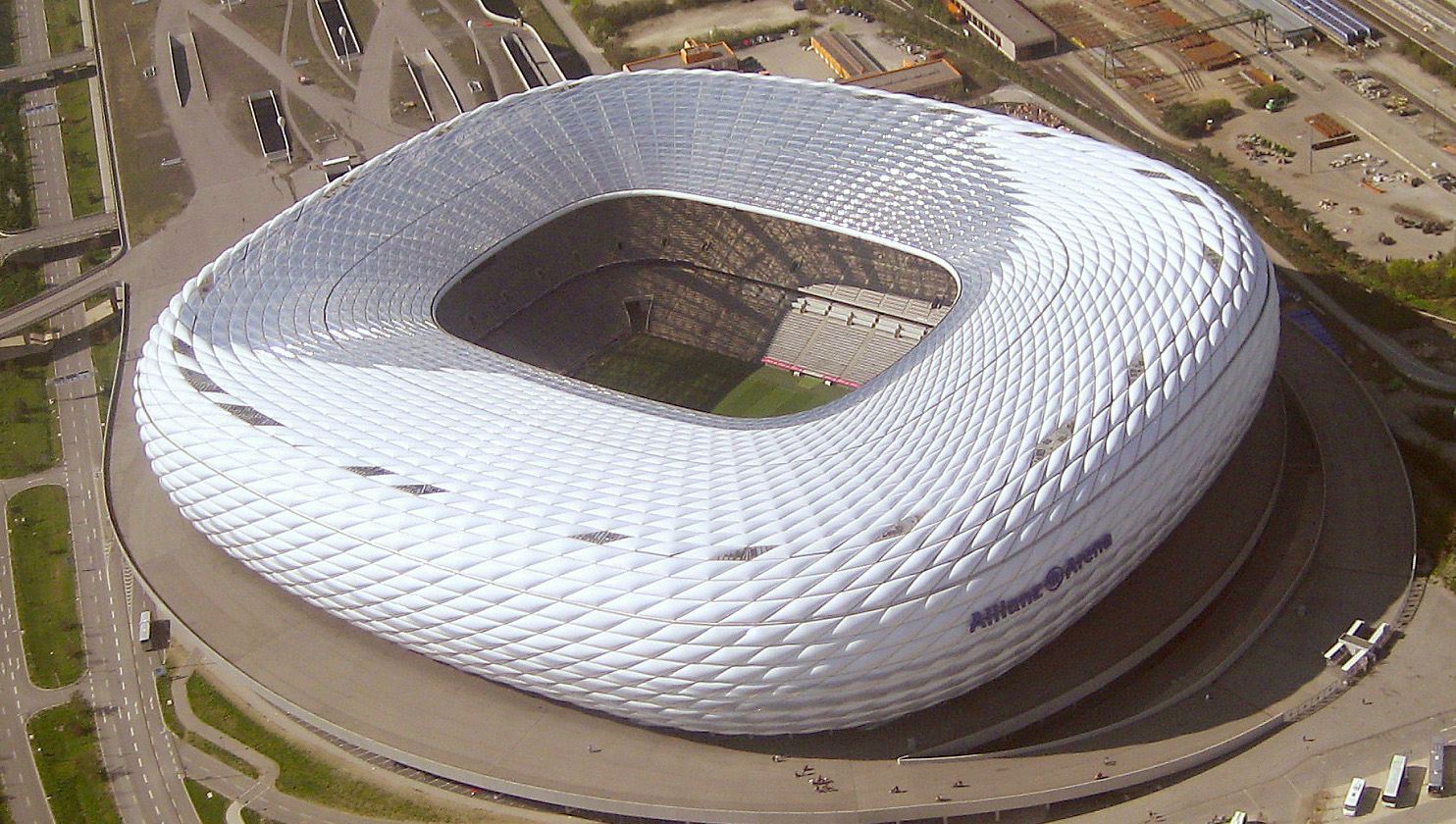
Olympiaturm (Olymptic Tower). In the NM “Modern Architecture Buildings” series, this tower is 291m high (antenna 109m) with an observation platform at 190m and a small rock and roll museum. At 182m, there is a revolving restaurant that seats 230 with a full revolution taking 53 minutes. It also serves as a broadcast tower. Hours are 9am to midnight.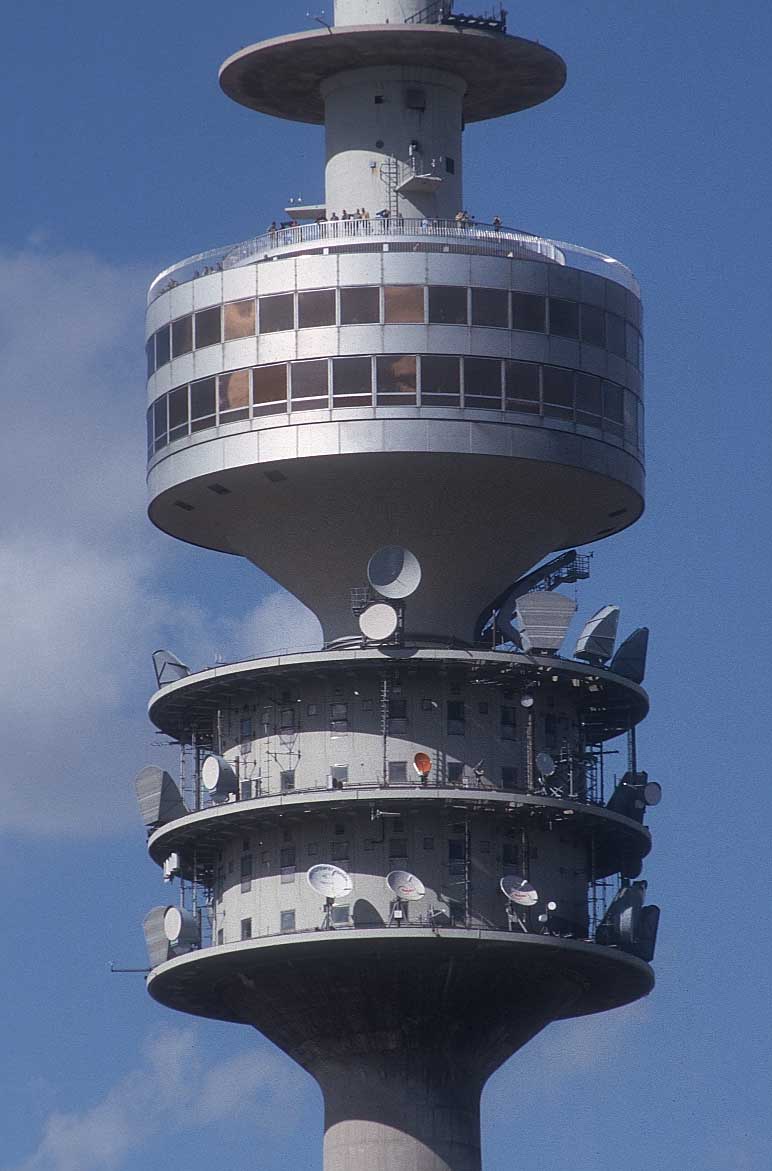
BMW Museum. All you want to know about BMW in this furturistic museum – engines, racing cars, antiques and Mini’s an affiliate of BMW. €10
BMW Welt is a futuristic glass and aluminum building across from the museum with all the new models of motorcycles, cars, Minis and Rolls Royce cars.
Munich Hbf. This classic stone building has an imposing green copper square roof with a sky light and the usual shopping. It is one of three Munich stations offering long distance services and handles about 450,000 passengers per day. It has 32 platforms plus a metro station and bus station.
It was opened in 1849 and has been rebuilt many times especially after WW II when it was badly damaged. It consists of several buildings constructed at various times with no cohesion between them. They also have varying facades.
Frauenkirche. This 3-nave church has aisles as high as the central nave with cream stone rib vaulting. There are 12 side chapels per side all with art and modern stained glass. The choir stalls have 16 large wood half figures per side on the back of the stalls. The highlight is the tomb in the right front (German only) but with kneeling soldiers on the corners and a grand canopy over the figures. The exterior has many grave slabs and great wood carved doors in the portals.
New Town Hall on Marienplatz. 100m long, the main façade is richly decorated with the entire line of the Wittelsbach dynasty making it the largest princely cycle in a German town hall. The ground level is almost completely occupied by the Ratskeller Restaurant. A highlight is the mechanical clock in the 85m high tower. Dancers twirl. With 43 bells (10 to 1,300kgs), it plays daily at 11, 12 and 5pm (only from March to October). The 32 figures refer to motifs from the history and legend of Munich. In the upper portion, a tournament is staged with heroes, jesters, cheering fans and pagans.
St. Peter’s Church. The tower was bombed in April 1944 and then entire church destroyed in December 1944. After 5 years of rebuilding it reopened in 1950.
This RC church is red brick with grave slabs on the exterior sides. Inside the style is baroque with large murals on the ceiling and high side walls, stucco ceilings in the aisles, much gilt, statues of the 12 apostles on the columns, and 6 chapels per side each with art and tombs. There is no stained glass. I arrived during service – the congregation was very small.
Viktualienmarkt. This street market has all kinds of eateries, and some vegy, flower and other kinds of stalls.
Asamkirche. Built by Egid Quirin Asam (1733-) for himself and his brother Cosmas as he wanted to be buried here in his crypt under the church. It is small with over the top Baroque with marble, gilt, white statues and a balcony.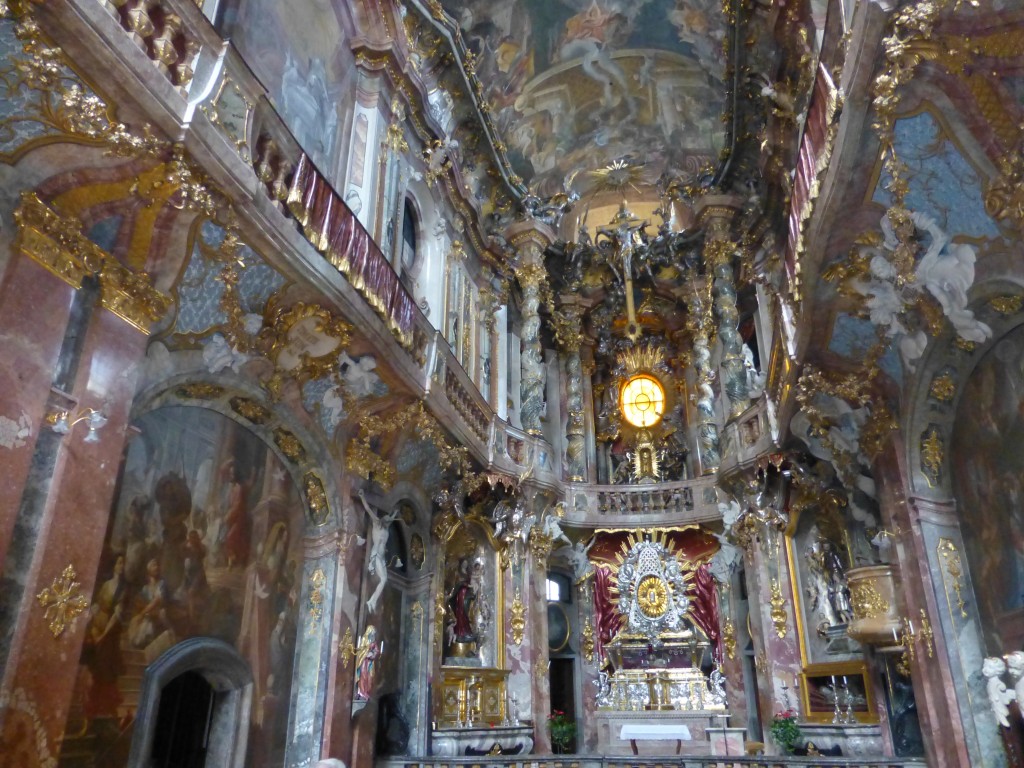
Bismarck statue. This red sandstone statue sits on the river at the entrance to a bridge. 
Nymphenburg Palace. Originally built by the Princes of Savoy from 1664-75, it was expanded by Maximillian Emanuel the heir to Bavaria adding 2 wing pavilions to the central pavilion in 1701. The façade was changed to Baroque in 1716. Stables and orangery were added in 1758 and then completed with a grand circle of Baroque mansions to create the monster of a palace it is today and it was the seat of the Holy Roman Emperor and residence of the rulers of Bavaria. The park was opened in 1792. Today it is the home of the House of Wittelsbach, the legitimate heirs of the Stuart claims to the thrones of England, Scotland, France and Ireland. The façade is 700m long. The interiors are Baroque and Rococco with famous ceiling frescoes in the 3-story central pavilion. Most other rooms have ceiling frescoes, hundreds of portraits of all the rulers, stucco, apartments, furniture, a coach collection, porcelain from the Nymphenburg porcelain factory. Since 1990, the Museum of Man and Nature is in the north wing.
The 200 acre park dating from 1671was redone in English style in the 19th century. It has the famous marble cascade and iron greenhouse, the Grand Cascade, a two part water staircase, fountains, 2 lakes on wither side of a canal and several garden pavilions. €11.50 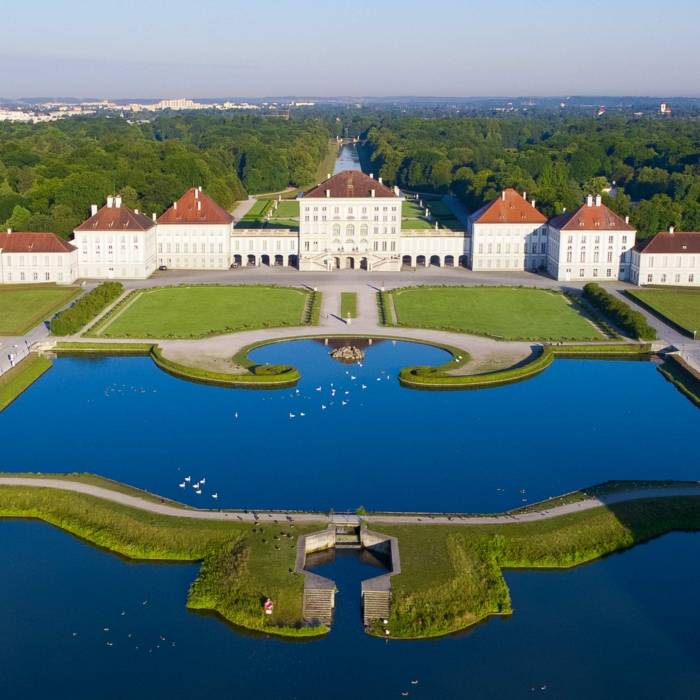

Botanischer Garten Muenchen-Nymphenburg. It is lovely with lakes and a famous alpine garden. €5.50
Dachau: Concentration Camp Memorial Site. Dachau operated from 1933-1945, the only Nazi camp to have existed for the entire duration of Nazi power. It was started in a WW I munitions factory but that was outgrown and in 1937-38 a new camp was built with 37 barracks designed for 6000 prisoners. At liberation there were 32,000 and severe overcrowding. In its 12 years, about 200,000 persons from throughout Europe were imprisoned and about 40,000 died.
As the first concentration camp and the main camp within German borders, it served as the prototype where the concentration camp model was formed, developed and as a training center for the SS “school of violence” who subsequently worked at other camps. That model was based on total control and terror – any minor infraction resulted in severe punishment. The initial prisoners were German political opponents. In 1938, political prisoners from annexed territories arrived plus 11,000 German and Austrian Jews; 1939 hundreds of Sinti and Roma; 1940 13,000 Polish; 1941 mass shooting of 4000 Soviet prisoners of war; 1942 2000 invalids. By 1943 there were 150 subsidiary camps most forced labour camps in the armaments industry – airplanes by Messerschmidt, BMW and Zeppelins. In 1944, all the sick were sent to Bergen-Belsen where they were not fed and basically left to die. The brutality of the guards was legendary and the name Dachau struck fear in Germany.
It was liberated by the Americans on April 29, 1945 and then used by them to imprison Nazi and SS members. It was a refugee camp until 1964 when the memorial site was established. Free
Enter the guard house where the gates have the same saying as Auschwitz (ARBEIT MACHS FREI). The large museum gives a detailed history of Germany after WW I, what led to the election of the National Socialist Party and the formation and functioning of the camp. There are many personal vignettes about individuals.
AUGSBURG
HYDRAULIC ENGINEERING and HYDROPOWER, DRINKING WATER and DECORATIVE FOUNTAINS IN AUGSBURG.
This shows 800 years of urban water management from the 15th to the early 20th century.
Augsburg used canals to collect clean water from the Stadtwald forest as early as 1216. The Hochablass weir was built in 1346 to guide water from the River Lech into a broad network of canals and was reconstructed several times between 1552 and 1912. The watercourses ran on the surface and so were endangered by contamination.
Water from the canals was raised using piston pump drives of reversible waterwheels via a set of levers. The boxed timber pipes that distributed water were very sensitive to pressure changes so open-compensation reservoirs were installed and these in turn necessitated the construction of towers, the precursors to later water towers. The key building of this phase was the Rotes Tor (Red Gate) that held the technical installations to pump and distribute the different water qualities into the city centre where three bronze drinking fountains designed by celebrated sculptors (Augustus, Mercury and Hercules) were installed around 1600.
In the 19th century industrialization process, cholera and hygiene research led to the use of deep wells and the water source and the towers were decommissioned. The neo-Renaissance Neubach waterworks was built in 1879 with horizontal pumps and four air pressure chambers to pump the water.
This led to the early industrialization of Augsburg encouraging textile, machine and paper factories. The existing watercourses outside the historic city walls were widened to supply the growing industrial demand for water and industry developed along the Lech and Wertach rivers. Waterpower was at first used for direct mechanical drives using waterwheels and turbines, but these were later followed by hydraulic electrical power generation.
The Groβe Wasserturm (large water tower) and the Kleine Wasserturm (small water tower), the Rotes Tor as well as the Untere Brunnneturm (Lower Waterworks) are essentially the oldest water towers in Germany and probably Central Europe. The water pumping techniques were derived from ore mining. The complex is a World Heritage Site.
Untere Brunnneturm. This 6-story square tower is on a small side street and is unmarked.
Augustusbrunnen. Situated in the main square, this white marble fountain has black statures: one at each corner and 8 on the column supporting Augustus. Each of the eight have small streams from fish, nipples and grotesques. 

Hercules Fountain. This is also a lovely fountain. A marble column with 3 bas-reliefs supports Hercules slaying a 6-headed mythical beast. Water comes out of jugs, animal’s mouths falling into the pentagonal base. 
Rotes Tor. This water tower has been renovated and doesn’t look old.
Schaezlerpalais. Built in 1767, this small white 3-story manor house houses the local art museum. The Hercules Fountain sits directly in front.
Augsburg Dom. This is a huge 5-nave church with high Gothic arched ceilings with the ribs meeting at unique carved rosettes surrounded by murals, carved pews and some murals (a high frieze in the main nave) and a huge figure on the right back wall. It has two choirs, one in the apse and one at the very back.
Fuggerei. This was the world’s first social housing in operation since 1521. It was founded by Jakob Fugger the Rich (1459-1525) as a social settlement for needy citizens of Augsburg. Rent (excluding heating) was and still is only one Rhine guilder (currently €.88 or 88 cents) plus three prayers per day for the founder and the Fugger family. Presently 150 persons occupy 140 apartments (each with its own entrance) in 67 buildings. Today that is only for local people in need and they have to be Catholic. The rent is historical in accordance with the practice of the day, people had to give something back in return. It is unique in age but also in continuity as it is still financed exclusively by an endowment.
It is a “city within a city” – it has 8 lanes and 7 gates, its own church, a school (founded in the 17th century but closed now), city walls, city gates, a hospital and a fountain.
The gates close at 10pm, arriving after incurs a €1 fine. It has a monument to Fugger, two-on-site museums (one with 3 rooms furnished as in 1500 and one in a WW II air raid shelter) and an apartment furnished in the current lifestyle of Fuggeri residents. Many buildings were destroyed in WW II. €6.50
Botanischer Garten – Japan Garten. This lovely botanical garden has a complete set of gardens representing almost every temperate climate including a dye plant garden, Roman garden, sage garden, Inverness garden, symbolic plants and a beer garden. €3.50
Augsburg Railway Park. This is a real hodge-podge of old railway stuff, it looks like a dumping ground for stuff that was hard to get rid of. Includes a steam locomotive and a complete high-speed train with at least 10 cars (TEE). €7
GO TO Germany – Baden-Württemberg (Stuttgart, Freiburg, Mannheim)
On September 21, I decided to return to souther Bavaria from Bregenz and the very NW of Austria to see The Pilgrimage Church of Wies and Neuschwanstein Castle. It added another 150kms of driving to the 4,200kms I had already driven in Germany.
At times I regretted the decision as the ⅔ of the road went though many villages with 50 speed zones and local traffic. From here I turned south to return to Austria and Innsbruck.
Pilgrimage Church of Wies (Church of the Scourged Savior)
In 1730, a priest and friar of the nearby Steingaden monastery built a figure of the scourged savior to be used in the Good Friday procession. It was put together using parts of several other wooden figures, the joints covered with linen and painted. It was put into the attic, then moved to a farm, the Wieshof where it became an object of veneration. During evening prayers on June 14, 1738, the Miracle of Wies took place – drops that appeared to be tears were noticed. The tiny 1740 chapel were soon too small to hold the many pilgrims from all over Europe.
The present church was built from 1746-54. That pilgrimage has continued till today with more than 1 million yearly visitors. The figure is in the low centre of the altar surrounded by gilt and marble.

Wow another spectacular Rococo church. The single nave is basically an octagon but with a circle of 8 sets of double columns, each with a marble statue (2 prophets and the 4 evangelists, Matthew, Mark, Luke and John), decorated in gold – mitres, staffs, books, fringe of their capes. The highlight though are the marvelous painted ceilings in the main nave, chancel and over the corridor between the outer walls and columns. The chancel, pulpit and 2 large side altars are over-the-top creations of marble, gilt and statues. There are several symbolic statues – a pelican and a lamb. The capitals and all the upper walls are a wealth of stucco and gilt decoration. The windows are simple clear glass honeycomb. Free
This is a World Heritage Site. I arrived for a mass and the church was half full. 

Dreams in Stone – the palaces of King Ludwig II of Bavaria: Neuschwanstein, Linderhof and Herrenchiemsee.
Neuschwanstein. A tentative WHS (15/01/2015), this romantic, storybook castle is famous for the tales of madness surrounding its lonely creator, “Mad” King Ludwig II. He lived in the castle for only 172 days before mysteriously dying in Lake Starnberger in 1886. At the time only 15 of the 200 rooms were finished.
This 5-story palace inspired Disney’s Sleeping Beauty Castle with its numerous turrets, balconies and balconies. King Ludwig built this in 1869 using his own personal fortune and loans. The impressive interior is decorated with paintings and symbols from German prehistory. The highlight is the Singer’s Room, a concert hall that takes up the entire length of the 4th floor is covered with intricate, rich decoration.
This is the tourist’s worse nightmare and visited by millions each year. Entrance tickets for Neuschwanstein Castle can only be bought at the Ticketcenter in the village of Hohenschwangau below the castle and can only be seen by guided tour. Tickets must be picked up no later than 1.5 hours before the time or will be forfeited. €13, 12 reduced, €2.50 reservation fee, Parking €7


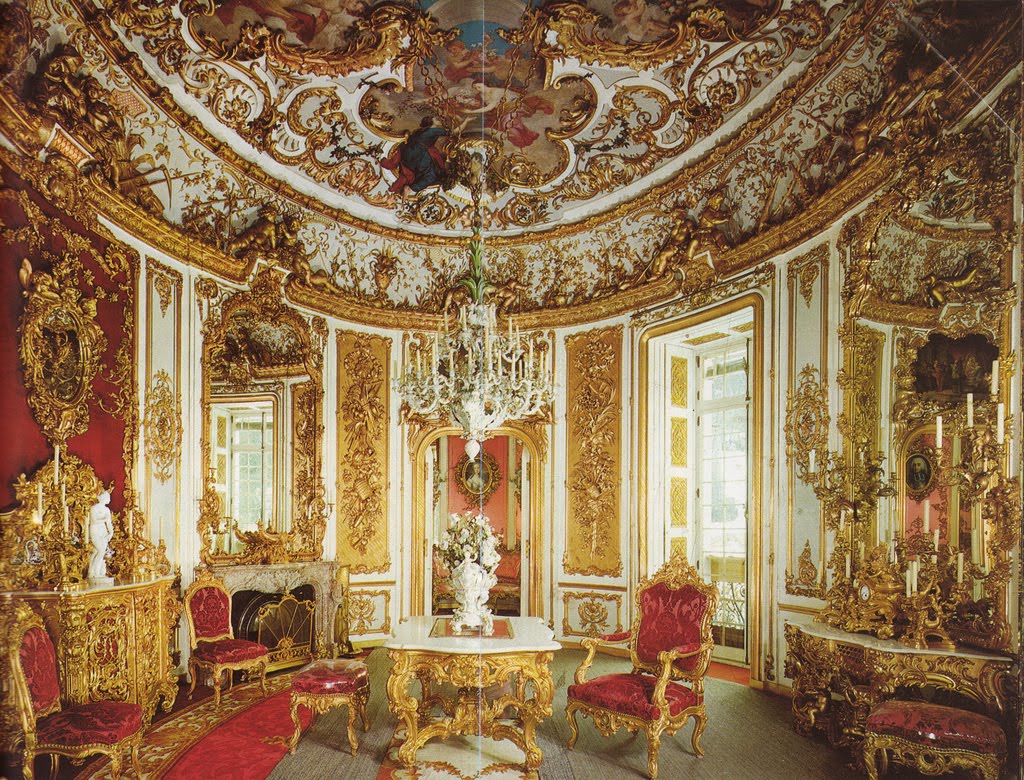
Lechfall. Just south of Neuschwanstein, this is a completely artificial waterfall created by a dam built in 1784-7 by the merchants of Füssen after a disastrous flood. The dam diverts water through a tunnel that generates electricity since 1903. There is an overflow dam then four 1-2m wide steps dropping 12m into a small pool. 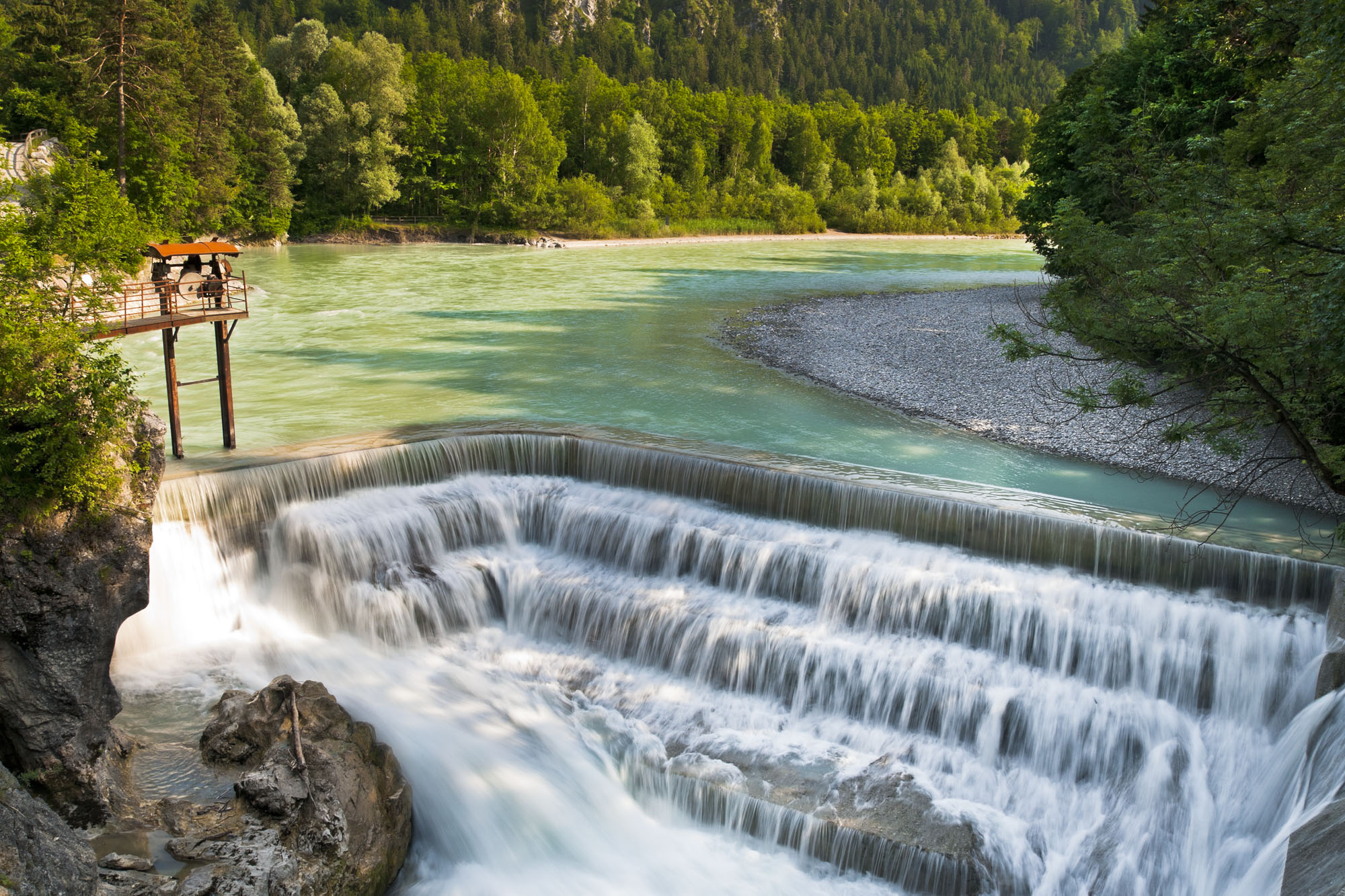
The river then flows through a gorge with 30 hydroelectric plants before eventually flowing into the Danube.
The Lechweg is a 78km trail that descends from the source lake in Austria, winding through villages. Upstream is one of the few “natural” rivers in Germany.
NOMAD MANIA Germany – Bavaria (Munich, Nuremberg, Würzberg)
World Heritage Sites
Frontiers of the Roman Empire
Hydraulic Engineering and Hydropower, Drinking Water and Decorative Fountains in Augsburg
Margravial Opera House Bayreuth
Old town of Regensburg with Stadtamhof
Pilgrimage Church of Wies
Prehistoric Pile dwellings around the Alps
Town of Bamberg
Würzburg Residence with the Court Gardens and Residence Square
Tentative WHS
Dreams in Stone – the palaces of King Ludwig II of Bavaria: Neuschwanstein, Linderhof and Herrenchiemsee (15/01/2015)
Frontiers of the Roman Empire (04/02/2015)
Great Spas of Europe (11/08/2014)
Luther memorials in Saxony-Anhalt, Saxony, Bavaria and Thuringia (15/01/2015)
Sights
Aschaffenburg Old Town
Berchtesgaden and Königssee
Hofbräuhaus am Platzl
Miltenberg
Mittenwald
Pfaffenwinkel (Bavaria)
Reichsparteitagsgelände
Rothenburg ob der Tauber
Walhalla
Borders
Austria-Germany
Czechia-Germany
Germany (sea border/port/river)
XL: Passau on right bank of Inn river
Railway, Metro, Funiculars, Cable Cars
Eibsee Cable Car
ICE 3 Routes
Kampenwand Cable Car
Mellrichstadt–Fladungen railway
Nebelhorn Cable Car
Predigtstuhl Cable Car
Tegelberg Cable Car
Wendelstein Cable Car
Zugspitze Glacier Cable Car
Zugspitze Railway
Castles, Palaces, Forts
Eichstätt: Willibaldsburg
Ettal: Linderhof Palace
Lichtenau: Lichtenau Fortress
Mespelbrunn: Mespelbrunn Castle
Schwangau: Neuschwanstein Castle
Religious Temples
Andechs: Andechs Abbey
Ettal: Ettal Abbey
Kelheim: Weltenburg Abbey
Passau: St. Stephen’s Cathedral
Steingaden: Wieskirche (Pilgrimage Church of Wies)
Modern Architecture Buildings: Schwandorf: Built Landscape
World of Nature
Bavarian Forest
Berchtesgaden
Experiences
Experience Almabtrieb
Play/hear Volkszither (Bavaria)
Entertainment/Things to do: Erding: Therme Erding
Botanical Gardens: Katse Botanical Gardens
Theme Parks
Günzburg: Legoland Deutschland Resort
Waterfalls
Lechfall
Röthbach Waterfall
Caves
Bing Cave
Devil’s Cave (Pottenstein)
Schellenberg Ice Cave
Ski Resorts
Alpenwelt Karwendel
Alpsee-Grünten
Nebelhorn Ski Resort
Oberaudorf Hocheck
Ochsenkopf Ski Resort
Ski resort Arber
Zugspitze Glacier Ski Resort
Monuments
Donaustauf: Walhalla
Kelheim: Liberation Hall
Open-Air Museums: Tittling: Bavarian Forest Museum Village
Aviation Museums
Feucht: Hermann Oberth Space Travel Museum
Niederalteich: Gerhard Neumann Museum
Oberschleißheim: Deutsches Museum Flugwerft Schleissheim
Railway Museums
Freilassing: Freilassing Locomotive World
Nördlingen: Bavarian Railway Museum
The Dark Side
Berchtesgaden: Kehlsteinhaus
Dachau: Concentration Camp Memorial Site
European Cities
ERLANGEN
AUGSBURG
World Heritage Sites: Hydraulic Engineering and Hydropower, Drinking Water and Decorative Fountains in Augsburg
Railway, Metro, Funiculars, Cable Cars: Augsburg Trams
Castles, Palaces, Forts: Augsburg: Schaezlerpalais
Entertainment/Things to do: Augsburg: Fuggerei
Zoos: Augsburg Zoo
Botanical Gardens: Augsburg: Botanischer Garten – Japan Garten
Planetariums: Augsburg: Sparkassen-Planetarium Augsburg
Railway Museums: Augsburg: Augsburg Railway Park
INGOLSTADT
Vehicle Museums: Museum Mobile
Museums
Bavarian Army Museum
German Medical History Museum
MUNICH World Cities and Popular Towns
Tentative WHS: Linderhof and Herrenchiemsee (15/01/2015)
Airports: Munich (MUC)
Railway, Metro, Funiculars, Cable Cars
Munich Hbf
Munich Trams
Munich U-Bahn
Museums
Alte Pinakotek
Bavarian National Museum
Beer and Oktoberfest Museum
Deutsches Museum
German Hunting and Fishing Museum
Glyptotek
Haus der Kunst
Jewish Museum
Kunsthalle
Lenbachhaus
Munich City Museum
Museum Brandhorst
Museum Five Continents
Museum of Man and Culture
Neue Pinakotek
Pinakothek der Moderne
Villa Stuck
Castles, Palaces, Forts
Nymphenburg Palace
Residenz
Religious Temples
Asamkirche
Frauenkirche
St. Peter’s Church
Modern Architecture Buildings
Allianz Arena
Olympiaturm
Zoos: Tierpark Hellabrunn
Botanical Gardens: Botanischer Garten Muenchen-Nymphenburg
Aquariums: Sea Life Centre
Vehicle Museums: BMW Museum
Monuments: Bismarck statue
Markets
Munich Flea Market (3 listed)
Viktualienmarkt
Festivals
Radikal jung
Theaterfestival Spielart
Oktoberfest
NUREMBERG/FÜRTH World Cities and Popular Towns
Airports: Nuremberg (NUE)
Railway, Metro, Funiculars, Cable Cars: Nuremberg Hbf, Nuremberg Trams, Nuremberg U-Bahn
Museums
City Museum at Fembo House
Germanisches Nationalmuseum
Kunsthalle
Museum of Industrial Culture
Neues Museum
Nuremberg Toy Museum
Nuremberg Transport Museum/Communications Museum
House Museums/Plantations: Albrecht Dürer’s House
Castles, Palaces, Forts
Neunhof Castle
Nuremberg Castle
Tucherschloss
Planetariums: Nicolaus Copernicus Planetarium
Railway Museums: DB Railway Museum
The Dark Side
Documentation Center Nazi Party Rallying Grounds
Medieval Dungeons
BAYREUTH
World Heritage Sites: Margravial Opera House
Museums: Bayreuth: Richard-Wagner Museum
Castles, Palaces, Forts
Hermitage Bayreuth
New Castle
Schloss Fantaisie
House Museums/Plantations: Wahnfried
Entertainment/Things to do:
Maisel’s Bier-Erlebnis-WeltAugsburg: Fuggerei
Margravial Opera House
REGENSBURG
World Heritage Sites: Old town of Regensburg with Stadtamhof
House Museums/Plantations: Regensburg: Kepler Memorial House
Museums: Regensburg: Haus der Bayerischen Geschichte – Museum
Pedestrian Bridges: Regensburg: Steinerne Brücke
Maritime/Ship Museums: Regensburg: Museum of Danube Shipping
WÜRZGURG
World Heritage Sites: Würzburg Residence with the Court Gardens and Residence Square
Railway, Metro, Funiculars, Cable Cars: Würzburg Trams
Museums: Röntgen Memorial Site
Castles, Palaces, Forts
Marienberg Fortress
Würzburg Residence
Entertainment/Things to do: Kulturspeicher
Pedestrian Bridges: Alte Mainbrücke
MEMMINGEN
Airports: Memmingen (FMM)
Museums: Memmingen: Heimatmuseum Freudenthal/Altvater
NEUENMARKT
Railway Museums: Neuenmarkt: German Steam Locomotive Museum
Vehicle Museums: Neumarkt in der Oberpfalz: Museum for Historical Maybach Vehicles
HOHENSCHWANGAU
Museums: Hohenschwangau: Museum of the Bavarian Kings
Castles, Palaces, Forts: Hohenschwangau: Hohenschwangau Castle
Pedestrian Bridges: Hohenschwangau: Marienbrücke
Villages and Small Towns
STRAUBING
TÜCHERSFELD
DINKELSBÜHL
MILTENBERG
OBERAMMERGAU
REIT IM WINKL
BAMBERG World Cities and Popular Towns
World Heritage Sites: Town of Bamberg
Museums: Bamberg: Historical Museum
Entertainment/Things to do: Bamberg: Franconian Brewery Museum
FUSSEN
Museums: Fussen: Museum der Stadt Fussen
GARMISCH-PARTENKIRCHEN
Tentative WHS: Alpine and pre-alpine meadow and marsh landscapes (historic anthropogenic landscapes in the area of “Werdenfelser Land”, “Ammergau”, “Staffelseegebiet” and “Murnauer Moos”, district Garmisch-Partenkirchen) (15/01/2015)
Museums: Garmisch-Partenkirchen: Werdenfels Museum
Ski Resorts: Garmisch-Partenkirchen Ski Resort
LINDAU
Sight Lindau and Lake Constance
Railway, Metro, Funiculars, Cable Cars: Lindau Railway Station
Museums: Lindau: Stadtmuseum Lindau
Lighthouses: Lindau: Lindau Lighthouse
MITTENWALD
Railway, Metro, Funiculars, Cable Cars: Mittenwald Railway (innsbruck-Mittenwald)
Museums: Mittenwald: Geigenbaumuseum
ROTHENBURG ob der TAUBER
Museums
Rotheburg: Medieval Crime Museum
Rothenburg: Imperial City Museum (Reichsstadtmuseum)
ROTTACH-EGERN
Museums: Rottach-Egern: Kutschen- Wagen- und Schlittenmuseum
Festivals
Bayerische Theatertage
Erlangen: Bergkirchweih
Festival-Mediaval, Selb
Landshut: Landshut Wedding
Manching: Barthelmarkt
Samba Festival, Coburg
Straubing: Gäubodenvolksfest
Theater der Welt (Theatre of the World)
